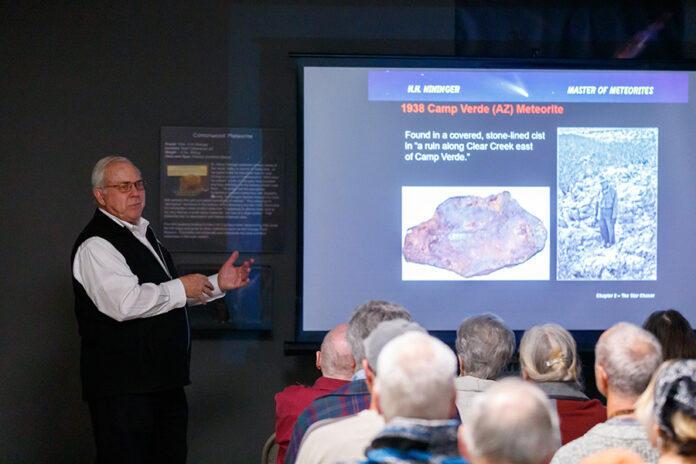Ken Zoll discussed his most recent book, “H.H. Nininger: Master of Meteorites,” at the Verde Valley Archaeology Center on Feb. 17.
Harvey Harlow Nininger was born in 1887 and attended McPherson College in Kansas, where he later taught biology. In November 1923, he saw both a photograph of Meteor Crater in a newspaper article and a meteor in the sky. Nininger subsequently dedicated his life to finding meteorites. He developed the first strategy for finding a witnessed fall and made newspaper appeals to the public for information about the locations and directions of falls they had witnessed.
In 1925, Nininger took a year-long Southwestern trip in his custom built house car. He collected specimens, lectured on meteorites and visited the famed Meteor Crater. Three years later, he took a small group of students on a nationwide trip, covering 19,000 miles in 36 weeks. He lectured along the way and traded meteorites.
Nininger moved to Denver in 1930 to become curator of meteorites at the Colorado Museum of Natural History. He later opened the Nininger Laboratory and set up a meteorite cutting lab that utilized a saw he had built. He also developed a public education program to help others learn to find meteorites.
In September 1937, Life magazine featured Nininger in a three page spread titled “Chasing Meteorites Is A Career.” Zoll called him a “master of social media of the day.”
Nininger also engaged farmers to help him locate meteorites. In 1927, he visited the Kansas meteorite farm, an area in Haviland, Kansas where ten tons of meteorites fell about 20,000 years ago.
Locals had been calling the meteorites “iron rocks” since the 1800s. Farmers had put them to use as weights for rain barrel covers and chicken coops, among other things. One farmer kept a fist-sized meteorite on hand to throw at a raging bull from time to time. Nininger wound up purchasing 1,200 pounds of meteorites at the farm.
At one point, Nininger’s collection accounted for half of the cataloged meteorites in the world. During the Great Depression, Nininger offered a dollar per pound for meteorites and received a swarm of letters and people offering him meteorites.
Nininger pioneered the use of certain technologies to harvest and study meteorites. In 1933, he excavated the Haviland Crater in Kansas in the first example of a crater being excavated to reveal the distribution of meteorites within it.
During the 1930s, he used an electromagnet to find fragments of the Odessa Meteorite in the first known use of an electromagnetic rake used for meteorite collecting. The rake turned up 1,500 fragments. Nininger was also the first to use a “magnetic balance instrument,” similar to a modern metal detector. Recalling his experiments, Zoll joked with the audience that they should try putting magnets on the bottom of their hiking sticks next time they go out and see what they find.
Nininger wrote his first book, “Our Stone-Pelted Planet,” in 1933, and went on to write many more, including his most significant work, 1956’s “Arizona’s Meteor Crater.”
Nininger spent 16 years studying Meteor Crater and the Canyon Diablo Meteorite that formed it. At a 1948 meeting of the American Astronomical Society, Nininger convinced the society to pass a motion supporting the nationalization of Meteor Crater and its transformation into a state or national park. The Barringer family, who owned the land containing the crater, terminated Nininger’s exploration rights and removed any reference to him from the displays at the crater’s museum.
After deciding to create his own museum to showcase his collection, Nininger and his wife Addie scouted locations in Flagstaff in 1946 before relocating the collection from Denver to a building on Route 66 near Meteor Crater they called the American Meteorite Museum. The Niningers moved the museum to Sedona in September 1953 after the construction of Interstate 40 bypassed the old Route 66 and visitation decreased. Sedona was not yet a tourist town and the Niningers sold much of the collection to the British Museum by the fall of 1957.
With the funds raised by the sale, the Niningers traveled to Australia to research the Dalgaranga Crater. They sold the remainder of the collection, approximately 1,300 meteorites weighing seven and a half tons, to Arizona State University in 1960.
Although retired, Nininger kept writing, publishing “Ask a Question About Meteorites” in 1961 and his autobiography “Find a Falling Star” in 1972. He died on March 1, 1986, shortly after the return of Halley’s Comet, which he had been eagerly anticipating.



